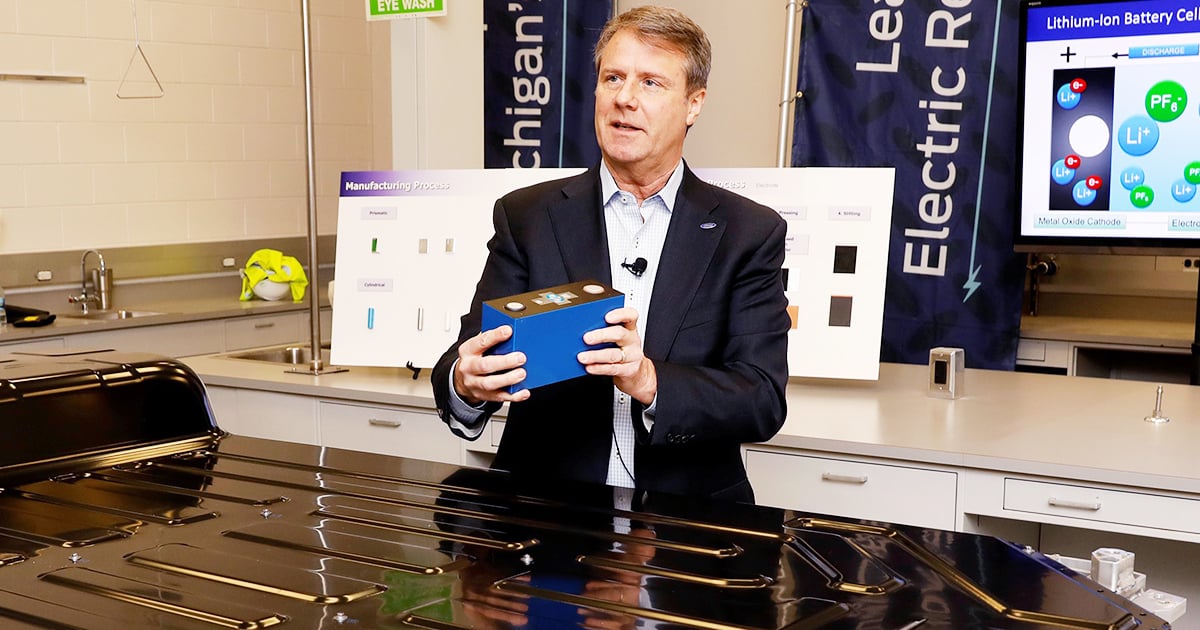
DETROIT — Ford Motor Co. in the coming months will offer two different battery chemistries on its electric vehicles as the automaker introduces a lower-cost and shorter-range alternative to the packs it uses today.
But its customers, Ford said, many of whom are new to EVs, won’t be saddled with confusing purchase decisions over specific chemistries, as the options will be woven into already-established configurations based on battery range.
Today, all Ford EVs are equipped with batteries using a nickel cobalt manganese chemistry. Starting this spring, Ford will offer the less-expensive lithium iron phosphate chemistry on its Mustang Mach-E. This battery chemistry will come to the F-150 Lightning next year.
In addition to their low cost because of more readily available materials, lithium iron phosphate batteries are more durable and can be fully recharged more quickly, Ford said. That makes them better for customers who mainly use their vehicle for routine trips to work or school, or fleet operators with fixed routes.
Nickel cobalt manganese batteries, by contrast, can offer longer range and are more energy-dense, making them better for customers who take long road trips or need to tow or haul.
Despite the addition of a new battery chemistry, Ford’s EV customers will simply continue to select between a standard- range battery or an extended-range battery. Charles Poon, Ford’s global director of electrified systems engineering, said EVs with standard-range batteries will automatically get the lithium iron phosphate chemistry while extended-range models will continue to use nickel cobalt manganese batteries.
Still, Poon said the automaker plans to educate customers and dealers on the differences so they can make more informed purchase decisions.
“We will continue to utilize multiple media channels including FordPass to provide suggestions to our customers so they can maximize the experience irrespective of chemistry,” he said. “Dealer training is a core component of bringing any new product to market for both sales and service staff and we will continue on that process.”
Ford isn’t the first automaker to offer such choices.
In late 2021, Tesla began offering lithium iron phosphate batteries on standard-range models. Stellantis plans to offer them on EVs in Europe, while General Motors could add lithium iron phosphate as it works to reduce EV costs, as well.
“LFP has a number of major advantages over nickel-rich chemistries,” Sam Abuelsamid, principal analyst with Guidehouse Insights, told Automotive News.
Chief among them is cost. Lithium iron phosphate batteries are 30 to 40 percent cheaper than nickel cobalt manganese batteries, mostly because minerals such as iron and phosphorous are abundant throughout the world, Abuelsamid said.
That’s especially appealing to Ford. Company executives have said Ford’s EVs are not profitable and likely won’t be until reaching their second generation in 2026. Ford slashed prices of its Mach-E after Tesla announced similar cuts, but it has raised the price of the Lightning multiple times since the 2021 launch of the pickup, with the base model up roughly $15,000 over its original price.
One downside to lithium iron phosphate is that range may suffer. Because these batteries don’t contain energy-dense nickel, EVs equipped with them can’t go as far, although their faster charging times and longer life cycles can make up for that.
Lithium iron phosphate batteries can be attractive to EV customers who don’t travel far every day and who have access to home or public charging.
“Not every EV needs to have a 500- or 600-mile range,” Abuelsamid said. “There’s a lot of applications where having 150 to 200 miles of range is more than adequate.”
Poon declined to say if the addition of lithium iron phosphate batteries on standard-range models will reduce the distance these EVs can travel on one charge, noting that the different chemistries “can provide very similar” numbers.
Abuelsamid said lithium iron phosphate batteries could have a more efficient battery pack design than their nickel cobalt manganese counterparts, which could make up for some of the range deficit.
The initial lithium iron phosphate batteries for the Mustang Mach-E and F-150 Lightning will be supplied by Contemporary Amperex Technology Co. Ford plans to build a $3.5 billion battery plant in Marshall, Mich., that will be dedicated to local production of these battery packs.
Scheduled to open in 2026, the plant will operate as a wholly owned Ford subsidiary using technology from CATL. It will employ 2,500 workers and have the capacity to build 35 gigawatt-hours of lithium iron phosphate cells a year, which is enough to power about 400,000 EVs.
“Ford’s electric vehicle lineup has generated huge demand. To get as many Ford EVs to customers as possible, we’re the first automaker to commit to build both NCM and LFP batteries in the United States,” CEO Jim Farley said in a statement at the plant announcement last month. “We’re delivering on our commitments as we scale LFP and NCM batteries and thousands, and soon millions, of customers will begin to reap the benefits of Ford EVs with cutting-edge, durable battery technologies that are growing more affordable over time.”